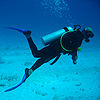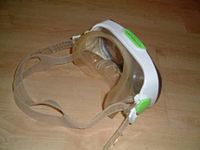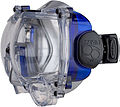- Diving mask
-
A diving mask is an item of diving equipment that allows scuba divers, free-divers, and snorkelers to see clearly underwater.[1] When the human eye is in direct contact with water as opposed to air, its normal environment, light entering the eye is refracted by a different angle and the eye is unable to focus the light. By providing an air space in front of the eyes, light enters normally and the eye is able to focus correctly.
Contents
Construction
Diving masks may have a single, durable, tempered glass plate in front of the eyes and a "skirt" of rubber or silicone to create a watertight seal with the diver's face.[1] Some masks may have two lenses, which in some cases allows the user to fit prescription lenses. In the case of freediving masks, which need to be low volume to minimise the change of pressure that occurs with depth, the lenses may be made of polycarbonate plastic. All masks have an elastic strap to keep them in position.[1]
Masks that are used at depth must be constructed so that the diver can exhale through the nose into the mask to prevent the "squeeze" caused by increasing pressure during descent in water.[2] The nose section of the mask also needs to be flexible to allow the diver to perform an eqalisation maneuver such as the valsalva maneuver or the frenzel maneuver when equalising pressure in the middle ear.
Some masks have a one-way purge valve under the nose to let water out. The diver simply holds the mask upright and exhales through the nose. While common in snorkeling, this feature is less favored by SCUBA divers because of the possibility of the valve failing at depth and leaving the user no means of clearing his mask. A simple and effective method for clearing a diving mask while underwater is to look down, place a finger on the top of the frame at either side, and slowly look up while exhaling through the nose.
Sometimes masks are sold in conjunction with snorkels and/or swimfins. Low quality snorkelling masks may have a low-quality plastic or glass faceplate, and are not recommended for anything but rare, casual use. Masks that have the snorkel built in are considered hazardous as well.
Divers often test whether a mask is a good fit by placing it on their face, without using the straps, and gently inhaling through their nose. If the mask stays on without any help this indicates that no air is being drawn in and that the fit is good.
Use
To prevent a mask from fogging up due to condensation on the glass plate many divers spit into the mask, wipe the spit around the inside of the plate and wash it out with a little water. There are commercial products that can be used as an alternative to the saliva method.
Refraction of light entering the mask makes objects in salt water appear about 34% bigger and 25% nearer when underwater, as shown in the underwater vision article. As the diver descends, the water acts as a colour filter eliminating the red end of the visible spectrum of the sunlight entering the water leaving only the blue end of the spectrum. Depending on the depth and clarity of the water, eventually all sunlight is blocked and the diver has to rely on artificial light sources to see underwater.
A variety of prescription lenses can be fitted inside the glass plate of the mask to correct some visual problems underwater. Divers may be able to use contact lenses inside the mask but they must keep their eyes closed if they remove the mask underwater to avoid losing the lenses. Double-dome masks restore natural sized underwater vision and field of view, while also correcting for a certain range of myopic vision. Mask removal and refitting is a basic skill that all divers are taught so that the diver can overcome floods or the mask being dislodged without panic.
When entering the water while wearing the mask, the diver normally needs to place a hand over the mask to disrupt fast water flow during entry. This prevents the mask from becoming dislodged or the glass damaged. Alternatively, a diver can enter the water with the mask off and then put it on or use an entry method such as the "forward roll", where the diver rolls forward with head entering the water first, which does not result in fast water flow over the mask.
Mask should always be rinsed inside and out with clean, fresh water after each day's use, and dried off after washing. A mask should not be stored in direct sunlight for long periods of time as ultraviolet light degrades the silicone. A well-maintained mask will last for many years.
Types of diving mask
Older diving masks had a single elliptical pane of glass. These masks have indentations underneath, either side of the nose. Divers can then put a thumb and forefinger in to pinch the nose, when performing a Valsalva maneuver to clear their ears. This design was improved by bringing the window closer to the face, reducing the volume of air inside the mask, thus making mask clearing easier. The window has a cutout to fit over the nose, which is covered by the rubber or silicone material of the mask. This facilitates pinching the nose when ear-clearing.
A further development is the mask with two windows, one window for each eye. It can have the windows closer to the face than the one-window type, and therefore contain even less space for the diver to have to blow water out of if the mask floods. These types are often called a "low-volume mask".
Recent innovations have produced more complex designs, intended to provide extra features:
- The double-dome mask. This was invented by HydroOptix. Double-dome masks allow a wider field of view and avoid the refraction error in perceived distance and size of objects. Underwater the curved mask windows make the diver's vision effectively more hyperopic, or less myopic, and the diver must wear special contact lenses to compensate (unless his eyes are myopic to the right amount to compensate exactly for the refraction at the curved mask windows). The diver's vision will become myopic when he puts his head out of water with the contact lenses in.[3]
- The "Data Mask", developed by Oceanic, is an eyes-and-nose diving mask with a built-in LCD display which displays various dive and breathing set conditions including the function of a diving computer. It is currently very expensive.[4]
Related equipment
There are several specialised types of diving headgear or outerwear:
- full face diving mask - often worn by working divers who need underwater verbal communication ability.
- diving helmet - often worn by divers using surface supplied diving equipment.
- hard hat - part of the old fashioned standard diving dress.
- fluid filled mask - the need to equilibrate the internal pressure in the mask by exhaling air through the nose reduces the freediver capacity to dive deep. Masks or swimming goggles with high power lenses (40-200 diopters) have been developed in this view: they are filled with water or saline fluid.[5]
References
- ^ a b c Professional Association of Diving Instructors (2008). Encyclopedia of Recreational Diving (3rd ed.). Rancho Santa Margarita, CA: PADI. ISBN 1878663011.
- ^ Butler, FK; Gurney, N (2001). "Orbital hemorrhage following face-mask barotrauma". Undersea and Hyperbaric Medicine (Undersea and Hyperbaric Medical Society) 28 (1): 31–4. PMID 11732882. http://archive.rubicon-foundation.org/2365. Retrieved 2008-07-06.
- ^ "Discover What You Have Been Missing!". HydroOptix. 30 April 2009. http://www.hydrooptix.com/index2.html. Retrieved 2009-09-23.
- ^ "DataMask HUD". Oceanic Worldwide. 2007. http://oceanicworldwide.com/p_computers_iddm_development.html. Retrieved 2009-09-23.
- ^ "Fluid Goggles". Liquivision Products. 2009. http://liquivision.com/fluidgoggles.php. Retrieved 2009-09-23.
Further reading
- Alexander, JE (1977). "Allergic reactions to mask skirts, regulator mouthpieces, and snorkel mouthpieces.". South Pacific Underwater Medicine Society Journal 7 (2). ISSN 0813-1988. OCLC 16986801. http://archive.rubicon-foundation.org/6144. Retrieved 2008-07-06.
- Chou, Brian; Legerton, Jerome A; Schwiegerling, Jim (2007). "Improving Underwater Vision: Contact lenses and other options can help patients safely maximize their vision underwater.". Contact Lens Spectrum (June). http://www.clspectrum.com/article.aspx?article=100720. Retrieved 2009-06-27.
- Olsson, DJ; Grant, WD; Glick, JM (2008). "Conjunctivitis outbreak among divers". Undersea and Hyperbaric Medicine (Undersea and Hyperbaric Medical Society) 35 (3): 169–74. PMID 18619112. http://archive.rubicon-foundation.org/8100. Retrieved 2009-08-07.
External links
- Deep Ocean Diving's Ocean Science – Explanation of the physics of underwater vision.
Underwater diving Types: 
Specialities: Equipment: Diving suit · Scuba set · Rebreather · Dive computer · Diver propulsion vehicle · Mask · Fins · Snorkel · Buoyancy control deviceDisciplines: Professional diving · Police diving · Military diving · Underwater photography · Underwater videographyHazards: Related: Categories:- Underwater diving
- Diving equipment
- Fishing equipment
- Masks
Wikimedia Foundation. 2010.






